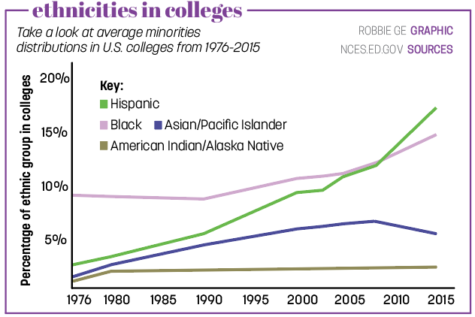
Last month, a Massachusetts federal judge ruled in favor of Harvard in a high-profile case brought up by Students For Fair Admissions (SFFA), upholding Harvard University’s controversial and unspoken policy of “positive discrimination” toward minority students. The center of debate, affirmative action, is a tricky topic: If you support it, then you’re inherently supporting inequality; if you don’t, then you’re supporting inequality, too. For a society still grappling with the discrimination, though, we need to take a long, hard look at affirmative action.
The fact is, affirmative action unfairly punishes those who are successful. Supporters of affirmative action like to say it acts as “positive discrimination,” rectifying historical mistreatment. However, the idea of “tipping” aspects for select applicants without affecting the outcomes of others, as Harvard University’s legal team so blatantly claimed, is ridiculous in any world where admissions are limited. The truth is that discrimination is a two-way street. There is no “positive discrimination” without negative discrimination to someone else. As SFFA highlighted, that means Asian-Americans. In upholding affirmative action, universities are simply shifting discrimination from one group to another.
 Furthermore, there is no reason why affirmative action needs to be based on race. Although race is often associated with socioeconomic status, it is far from the only factor. Income, education and occupation are far more important factors. Thus, the argument for using race alone as a factor in giving some students a “push” in their future economic status is ignorant at best. Even so, despite common perceptions of the “model minority” myth with Asian-Americans, a recent report from the Pew Research Center finds that the group actually suffers from the greatest wealth disparity of any cohort in the United States. Although Asian-Americans are the most successful economically as a group, lower-income Asian-Americans trail far behind their lower-income African-American and Caucasian counterparts. Thus, explicit systematic discrimination against Asian-Americans, as shown through Harvard College’s“personality scores,” is even less justified.
Furthermore, there is no reason why affirmative action needs to be based on race. Although race is often associated with socioeconomic status, it is far from the only factor. Income, education and occupation are far more important factors. Thus, the argument for using race alone as a factor in giving some students a “push” in their future economic status is ignorant at best. Even so, despite common perceptions of the “model minority” myth with Asian-Americans, a recent report from the Pew Research Center finds that the group actually suffers from the greatest wealth disparity of any cohort in the United States. Although Asian-Americans are the most successful economically as a group, lower-income Asian-Americans trail far behind their lower-income African-American and Caucasian counterparts. Thus, explicit systematic discrimination against Asian-Americans, as shown through Harvard College’s“personality scores,” is even less justified.
The shaky moral grounds of introducing discrimination to other races could have been justified had it presented significant tangible benefits to social equality. That’s simply not the case. A recent New York Times analysis found that even after decades of affirmative action, African-Americans and Hispanics are more underrepresented in top colleges than 35 years ago. Affirmative action is not the silver bullet to solving centuries of historical oppression. In fact, it masks detrimental consequences like a wolf in sheep’s clothing. By taking attention away from the fact that discrimination still exists today, affirmative action creates the false image of a “post-racial” society.

It’s hard to clearly articulate your thoughts about affirmative action today without risking offending someone, but that doesn’t mean we shouldn’t talk about it. Although the federal judge sided with Harvard University, affirmative action is such a major issue that the Supreme Court will likely take up the case in the near future. In the meantime, we should all keep an open mind and critically consider all perspectives of this issue before taking a side.
The views in this column do not necessarily reflect the views of the HiLite staff. Reach Edward Dong at edong@hilite.org
















































































![Review: “The Immortal Soul Salvage Yard:” A criminally underrated poetry collection [MUSE]](https://hilite.org/wp-content/uploads/2025/03/71cju6TvqmL._AC_UF10001000_QL80_.jpg)
![Review: "Dog Man" is Unapologetically Chaotic [MUSE]](https://hilite.org/wp-content/uploads/2025/03/dogman-1200x700.jpg)
![Review: "Ne Zha 2": The WeChat family reunion I didn’t know I needed [MUSE]](https://hilite.org/wp-content/uploads/2025/03/unnamed-4.png)
![Review in Print: Maripaz Villar brings a delightfully unique style to the world of WEBTOON [MUSE]](https://hilite.org/wp-content/uploads/2023/12/maripazcover-1200x960.jpg)
![Review: “The Sword of Kaigen” is a masterpiece [MUSE]](https://hilite.org/wp-content/uploads/2023/11/Screenshot-2023-11-26-201051.png)
![Review: Gateron Oil Kings, great linear switches, okay price [MUSE]](https://hilite.org/wp-content/uploads/2023/11/Screenshot-2023-11-26-200553.png)
![Review: “A Haunting in Venice” is a significant improvement from other Agatha Christie adaptations [MUSE]](https://hilite.org/wp-content/uploads/2023/11/e7ee2938a6d422669771bce6d8088521.jpg)
![Review: A Thanksgiving story from elementary school, still just as interesting [MUSE]](https://hilite.org/wp-content/uploads/2023/11/Screenshot-2023-11-26-195514-987x1200.png)
![Review: "When I Fly Towards You", cute, uplifting youth drama [MUSE]](https://hilite.org/wp-content/uploads/2023/09/When-I-Fly-Towards-You-Chinese-drama.png)
![Postcards from Muse: Hawaii Travel Diary [MUSE]](https://hilite.org/wp-content/uploads/2023/09/My-project-1-1200x1200.jpg)
![Review: "Ladybug & Cat Noir: The Movie," departure from original show [MUSE]](https://hilite.org/wp-content/uploads/2023/09/Ladybug__Cat_Noir_-_The_Movie_poster.jpg)
![Review in Print: "Hidden Love" is the cute, uplifting drama everyone needs [MUSE]](https://hilite.org/wp-content/uploads/2023/09/hiddenlovecover-e1693597208225-1030x1200.png)
![Review in Print: "Heartstopper" is the heartwarming queer romance we all need [MUSE]](https://hilite.org/wp-content/uploads/2023/08/museheartstoppercover-1200x654.png)



